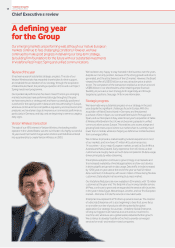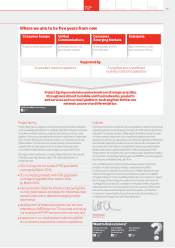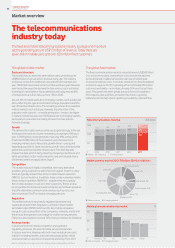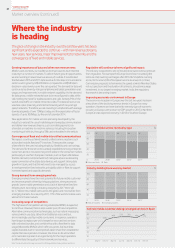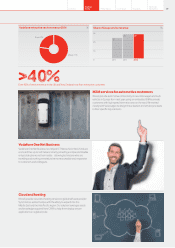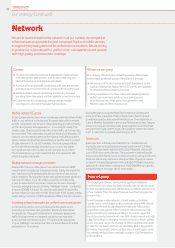Vodafone 2014 Annual Report Download - page 22
Download and view the complete annual report
Please find page 22 of the 2014 Vodafone annual report below. You can navigate through the pages in the report by either clicking on the pages listed below, or by using the keyword search tool below to find specific information within the annual report.
Market overview (continued)
Growing importance of data and other new revenue areas
Mobile voice and texts, our traditional revenue sources, have reached
maturity in a number of markets. To deliver future growth opportunities,
we are investing in newer revenue areas such as data. It is estimated
that between 2013 and 2017 data revenue for the telecommunications
sector is set to grow by US$128 billion, compared to a US$38 billion
decline in voice revenue over the same period. The demand for data will
continue to be driven by rising smartphone and tablet penetration and
usage, and improvements in mobile network capability. As the demand
for data grows, mobile networks have to be recongured to data, while
still meeting the need for traditional texts and calls. Already 91% of the
world’s total trafc on mobile networks is data. The data services most
used are video streaming and internet browsing which require high
speed networks. Therefore, we are investing in ultrafast 4G with average
download speeds of over 75Mbps today, and the expectation of faster
speeds, of up to 300Mbps, by the end of calendar 2014.
New applications for mobile services are being developed by the
industry to extend the use of mobile beyond everyday communication
and deliver new revenue streams, such as mobile payments via
a handset or machine-to-machine services, including the location
monitoring of vehicles, through a SIM card embedded in the vehicle.
Convergence of xed and mobile into unied communications
We expect a continued trend towards unied communications such
as bundled mobile, xed and TV services. These provide a range
of benets for the user, including simplicity, exibility and cost savings.
The demand for these services is already established among enterprise
customers and it is now becoming more visible in the consumer market,
particularly in southern European markets, such as Spain. We believe
that this demand, combined with technological advances delivering
easier connection of multiple data devices, will support strong data
growth in future, and that this will need to be managed by access
to next-generation xed networks, principally cable or bre, to support
increased speed and capacity demands.
Strong demand from emerging markets
Emerging markets have the most potential for future mobile customer
and revenue growth driven by rising populations, strong economic
growth, lower mobile penetration and a lack of alternative xed line
infrastructure. According to industry analysts, by 2017 there will
be 1.7billion new mobile users across the globe, and most will be from
emerging markets. As a result by 2017, 77% of the world’s mobile users
will be from these markets.
Increasing range of competitors
The high level of competition among established MNOs is expected
to continue. However, there is also a wider pool of new competitors.
Alternative communication technologies, such as instant messaging
services which use data, rather than traditional voice and text,
are increasingly used by mobile consumers. In response, operators
have begun to replace per unit charges for voice and text services
with unlimited bundles, and combine this with a xed fee for data
usage. Meanwhile MVNOs which offer low prices, but have little
capital invested, have in recent periods taken share from established
capital intensive operators. However, the move to 4G and unied
communications presents an opportunity for the major operators
to differentiate the quality of their networks and services.
Regulation will continue to have a signicant impact
The industry is expected to see continued downward revenue pressure
from regulation. For example the Europe Commission is seeking the
removal of all roaming surcharges after 2016 (for Vodafone roaming
accounts for around 6% of European service revenue). In contrast,
Commission proposals to harmonise the speed at which Member States
roll out spectrum and the duration of contracts, should encourage
investment. In our largest emerging market, India, the regulatory
framework is becoming clearer.
Improving economic environment in Europe
The economic recession in Europe over the last two years has been
a key driver of the declining revenue trends in Europe for many
operators. However, we have started to see early signs of economic
recovery in Europe, with a return to GDP growth in 2013 in Northern
Europe and an expected recovery in 2014 in Southern Europe.
Where the industry
is heading
The pace of change in the industry over the last few years has been
signicant and is expected to continue – with new revenue streams,
new users, new services, major improvements to networks, and the
convergence of xed and mobile services.
Note: The industry data on this page is sourced from Strategy Analytics, Analysys Mason and Ovum.
Sep 12
24%
Dec 12 Mar 13 Jun 13 Sep 13 Dec 13 Feb 13
0
20
10
30
40
50
60
% of new mobile customers taking converged services in Spain
44%
49% 51% 51% 49% 57%
2013
72 69 66 64 61
28 31 34 36 39
2014e2015e2016e2017e
0
20
40
60
80
100
Industry mobile service revenue by type %
2013
26 25 24 23 23
74 75 76 77 77
2014e2015e2016e2017e
0
20
40
60
80
100
Industry mobile phone users by market %
n Voice and texts n Data
n Mature markets n Emerging markets
Vodafone Group Plc
Annual Report 2014
Vodafone Group Plc
Annual Report 20142020




